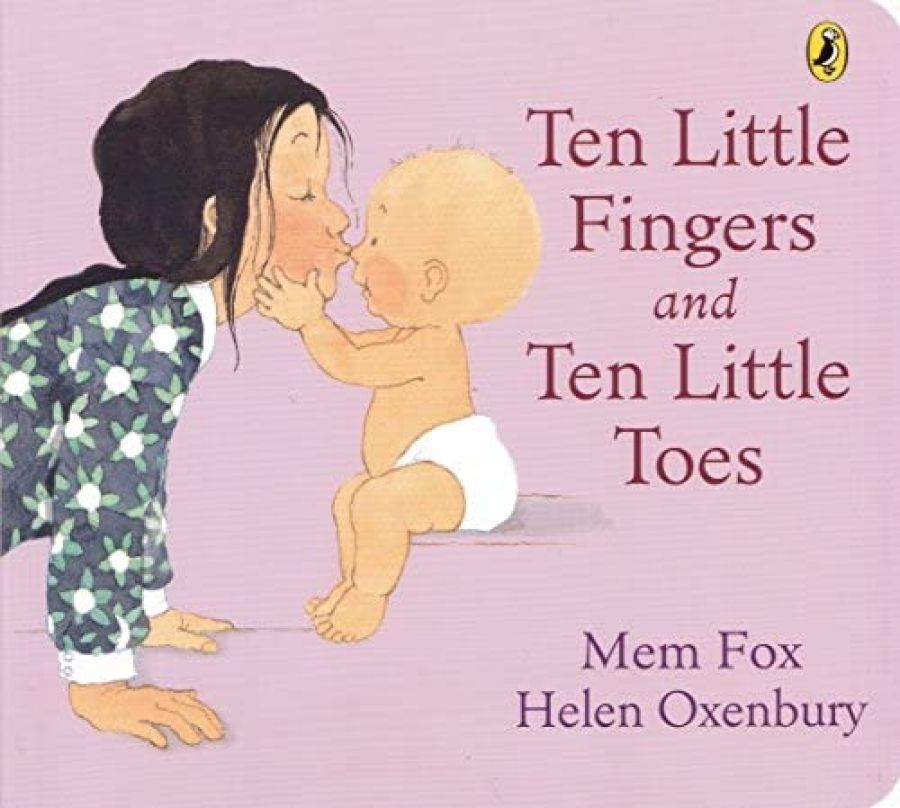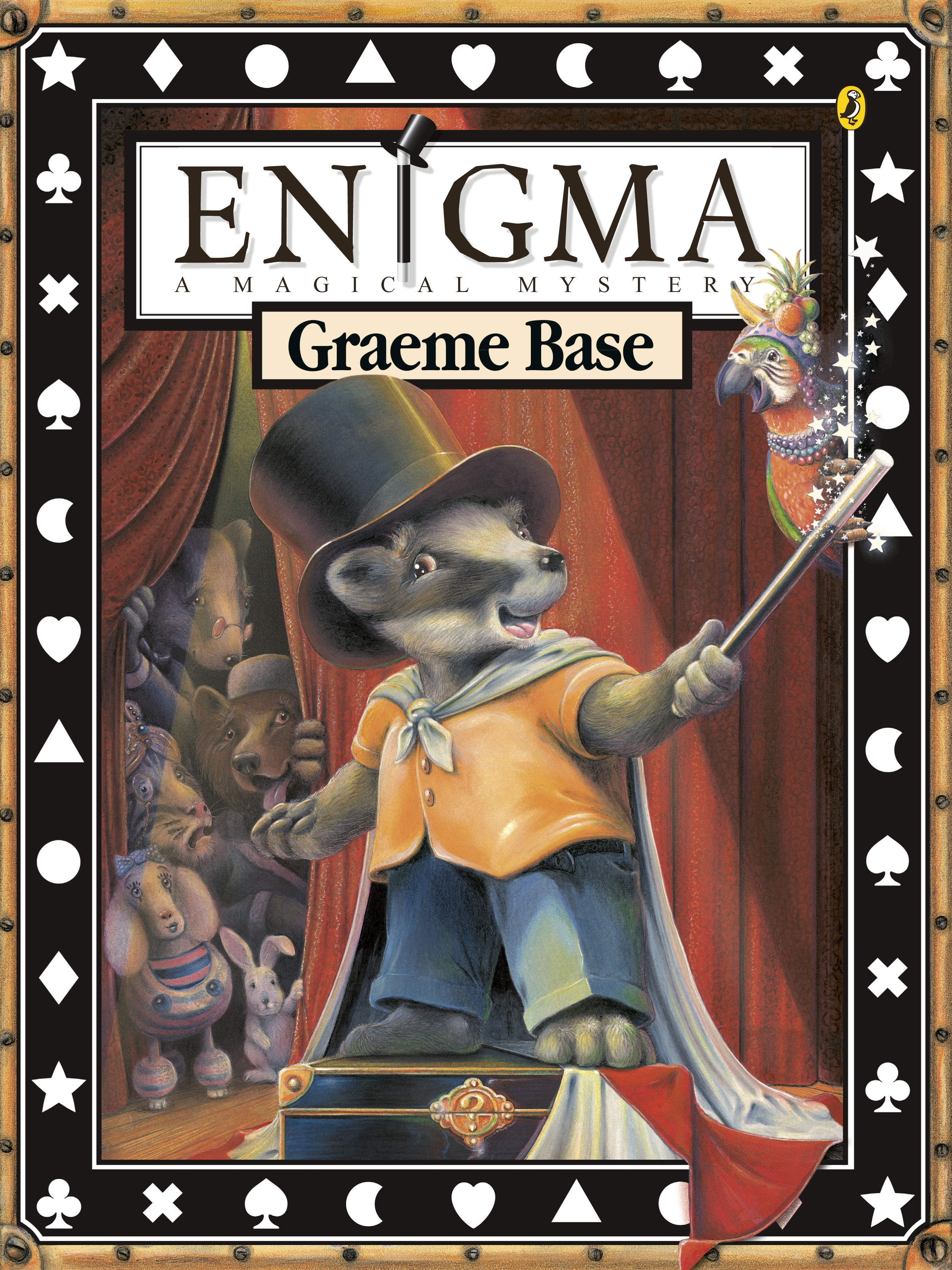
- Free Article: No
- Contents Category: Children's Fiction
- Review Article: Yes
- Article Title: Exploring traditions
- Online Only: No
- Custom Highlight Text:
While the children’s picture book is a relatively recent literary phenomenon, most picture book authors still tap into the strong traditions of oral storytelling. Multi-award winning author Mem Fox is particularly good at this. Fox’s picture book texts are firmly grounded in the three R’s – the traditional rhythms, rhymes and repetitions found in children’s songs and verses throughout the ages. This, combined with Judy Horacek’s inspired illustrations, was what made Where is the Green Sheep? (2004) such a success.
- Book 1 Title: Ten Little Fingers and Ten Little Toes
- Book 1 Biblio: Viking, $24.95 hb, 40 pp
- Book 2 Title: Enigma
- Book 2 Subtitle: A Magical Mystery
- Book 2 Biblio: Viking, $29.95 hb, 36 pp
- Book 2 Cover Small (400 x 600):

Oxenbury, a multi-award winning illustrator, had not illustrated for eight years until Fox’s manuscript came along. She described the text as being ‘as familiar as a nursery rhyme I had known all my life’. Fox’s lilting cadences and underlying message of tolerance and sharing have inspired Oxenbury to produce charming illustrations of both faraway landscapes and delectable children of every hue, who interact happily with both one another and the reader. Her toddlers are full of character and have a three-dimensional feel, as though you could tickle their little toes, which are just perfect for counting. Her depiction of the intimate moments between mother and child are enchanting. With its infectious text and mini-United Nations of bonny babes, Ten Little Fingers and Ten Little Toes is a perfect picture book to share with little ones, and one that is sure to become a modern classic. Graeme Base also employs rhythm and rhyme in the text of his latest elaborately constructed picture-puzzle book. Released to coincide with the publication of the sumptuous biographical tome, Julie Watts’s The Art of Graeme Base (which I reviewed in the December 2008–January 2009 issue of ABR), Base’s Enigma: A Magical Mystery (Viking, $29.95 hb, 36 pp, 9780670072019) adopts a similar format to his two most successful books, Animalia (1986) and The Eleventh Hour (1988). However, there is a reflective gentleness about it which was not present in his earlier work.
Base celebrates the grandfather–grandson relationship in a style that highlights his English origins. The colours are subdued, and the light soft and gentle. The main characters are badgers, and the retirement home for ageing magicians in which Bertie’s grandfather lives is in the English-inspired Federation style. However, the animals that Base depicts and the rooms they inhabit are international in flavour, and the architecture and interior design reflect his travels overseas and his fascination with a multitude of architectural styles and art movements, ranging from Art Deco, to Surrealism, to Chinese and Islamic art.
A comparison of the illustrations in Enigma with those in The Eleventh Hour reveals how Base’s style has evolved. Rather than exclusively relying on his excellent draughtsmanship and drawing skills, with colour added to lift the illustrations, Base now uses a more painterly style, with less reliance on strong outlines. His work has lost some of its amazing clarity and intricate detail, but this has been replaced with a more intimate and domestic ambience. However, the ornate borders that have become a trademark of Base’s work remain.
Base’s text is as flamboyant as ever, full of rambunctious rhymes and alliterative flourishes. It gambols along at a fast pace, drawing the reader into the tale of how Bertie saves the day when his grandfather and his colleagues have their special magic tricks stolen. There are clues galore for attentive children to find, and a ‘magical code breaker’ especially engineered into the back cover allows budding sleuths to work out just who the culprit is (but be warned, it is not easy). Base has produced yet another humorous, visually exotic and complex picture-puzzle book for children to pore over.
The comic book has been one of the staple forms of reading matter for children, especially boys, for over sixty years. The traditional format of garish colours, heavily outlined drawings, stereotypical characters, panelling and speech balloons has now morphed into the more sophisticated ‘graphic picture book’. Captain Congo and the Crocodile King (Working Title Press, $24.95 hb, 48 pp, 9781876288914), by Ruth Starke and Greg Holfeld, has everything you would expect from the genre: dynamic illustrations, a hunky hero (an indestructible and resourceful gorilla), a quirky sidekick (a penguin with attitude who provides comic relief), an exotic location (Abyssinia), a missing mild-mannered professor, scheming spies, scorpions, human sacrifice and, of course, lost treasure. For upper-primary and junior-secondary readers who like their plots fast moving and their characters larger than life, the unflappable Captain Congo and his irrepressible companion Pug deliver in this ‘The Phantom meets Tin Tin’ style adventure.
As divorce rates have risen, the traditional concept of a family has changed dramatically. Molly and Her Dad (Little Hare Books, $24.99 hb, 40 pp, 9781921272554), by Jan Ormerod and Carol Thompson, tenderly and joyfully explores how Molly, who is exuberant and loves to tell stories, copes with the fact that her Dad lives ‘a whole plane ride away’ and is thus not an integral part of her daily life. She has been told that she looks like him, but it is only when he comes to look after her for a week that Molly – or Mollymaloola, as her Dad affectionately calls her – realises just how much they have in common. Ormerod and Thompson have combined to deal empathetically and humorously with a subject which can be fraught. The text is chatty and highly readable; speech balloons in the illustrations add extra commentary. The illustrations are bright and fluid, full of life and humour, and Thompson’s depictions of Molly, her father and their interactions are totally engaging. This is a sensitive and warm story about family life in one of its many permutations.
Glenda Millard and Stephen Michael King have produced a wonderful and very Australian version of the traditional Christmas story in Applesauce and the Christmas Miracle (ABC Books, $24.95 hb, 32 pp, 9780733322495). Applesauce is, ironically, a small pink pig that is depressed about Christmas. The people that own her, Joe and Marigold, have lost almost everything to a bushfire which has ravaged their property. Christmas is looking bleak indeed, and when the owl tells Applesauce that Christmas comes from the heart, she finds that her heart is empty. But then the friendly Shepherd family come to stay, Marigold’s three wise aunties turn up with gifts, and a flock of cockatoos cavort overhead as they all celebrate the birth of Joe and Marigold’s baby. Suddenly, Applesauce’s heart is full to overflowing.
Millard’s text is poetic and lyrical, full of wonderful descriptions of orange evenings ‘tiger-striped with blackened trees’ and cockatoos ‘settling like snowflakes on the sooty paddocks’. She has created a perfect Australian version of the nativity without succumbing to the need to overdo the Aussie icons. Instead, her story is one of overcoming adversity, the importance of friends and family, the joys of sharing a simple repast, and the miracle of life – something to celebrate, indeed.
Millard’s text is perfectly matched by King’s loose-lined drawings and gentle watercolours, with cartoon-style people and animals whose evocative body language perfectly reflects the emotions in the text. King’s double-page spread of the star-lit, fire-ravaged countryside, with a glimmering star bathing a small hut and the sleeping pig in its light, will resonate with those who have experienced the terrors and the devastation of a bushfire. His nativity scene is particularly poignant. The Shepherds, the aunties, Marigold and Joe, and, of course, Applesauce, admire the new baby as it sleeps in a box lined with straw under the spreading branches of a burnt-out gumtree. Despite its Christmas theme, this book is perfect to share at any time of the year. After all, traditions have to start somewhere.


Comments powered by CComment